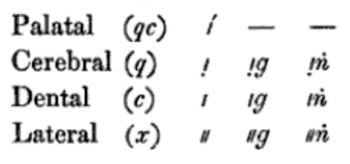Click letter
Various letters have been used to write the click consonants of southern Africa. The precursors of the current IPA letters, ⟨ǀ ǁ ǃ ǂ⟩, were created by Karl Richard Lepsius[1][2] and used by Wilhelm Bleek[3] and Lucy Lloyd, who added ⟨ʘ⟩.
Also influential were Daniel Jones, who created the letters ⟨ʇ ʖ ʗ ʞ⟩ that were promoted by the IPA from 1921 to 1989, and used Clement Doke[4][5] and .[6]
Individual languages have had various orthographies, usually based on either the Lepsius alphabet or on the Latin alphabet. They may change over time or between countries. Latin letters, such as c x q ç, have case forms; the pipe letters, ǀ ǁ ǃ ǂ, do not.[7]
Multiple systems[]

By the early 19th century, the otherwise unneeded letters c x q were used as the basis for writing clicks in Zulu by British and German missions.[8] However, for general linguistics this was confusing, as each of these letters had other uses. There were various ad hoc attempts to create letters—often iconic symbols—for click consonants, with the most successful being those of the Standard Alphabet by Lepsius, which were based on a single symbol (pipe, double pipe, pipe-acute, pipe-sub-dot) and from which the modern Khoekhoe letters ⟨ǀ ǁ ǃ ǂ⟩ descend.

Though not clear from this image, the descenders on the nasal clicks that bend to the right bear rings, while those that bend to the left are tails as in IPA ŋ and ɲ. That is, the nasal click letters are, respectively, n with a ring on the right leg, ŋ with a ring on the left leg, n with a ring on the left leg, ɲ with a ring on the right leg, and n with rings on both legs.
During the First World War, Daniel Jones created the equivalent letters ⟨ʇ ʖ ʗ ʞ⟩ in response to a 1914 request to fill this gap in the IPA, and these were published in 1921 (see history of the International Phonetic Alphabet).[9]
By 1911, if not earlier, Lucy Lloyd created the letter ⟨ʘ⟩ for bilabial clicks.
Clement Doke expanded on Jones' letters in 1923. Based on an empirically informed conception of the nature of click consonants, he analyzed voiced and nasal clicks as separate consonants, much as voiced plosives and nasals are considered separate consonants from voiceless plosives among the pulmonic consonants, and so added letters for voiced and nasal clicks. (Jones' palatal click letter was not used, however. Jones had called it "velar", and Doke called palatal clicks "alveolar".) Doke was the first to report retroflex clicks.

would publish a somewhat similar system in his phonetic description of Khoekhoe. Because Khoekhoe had no voiced clicks, he only created new letters for the four nasal clicks. Again, he didn't use Jones' "velar" click letter, but created one of his own, ⟨